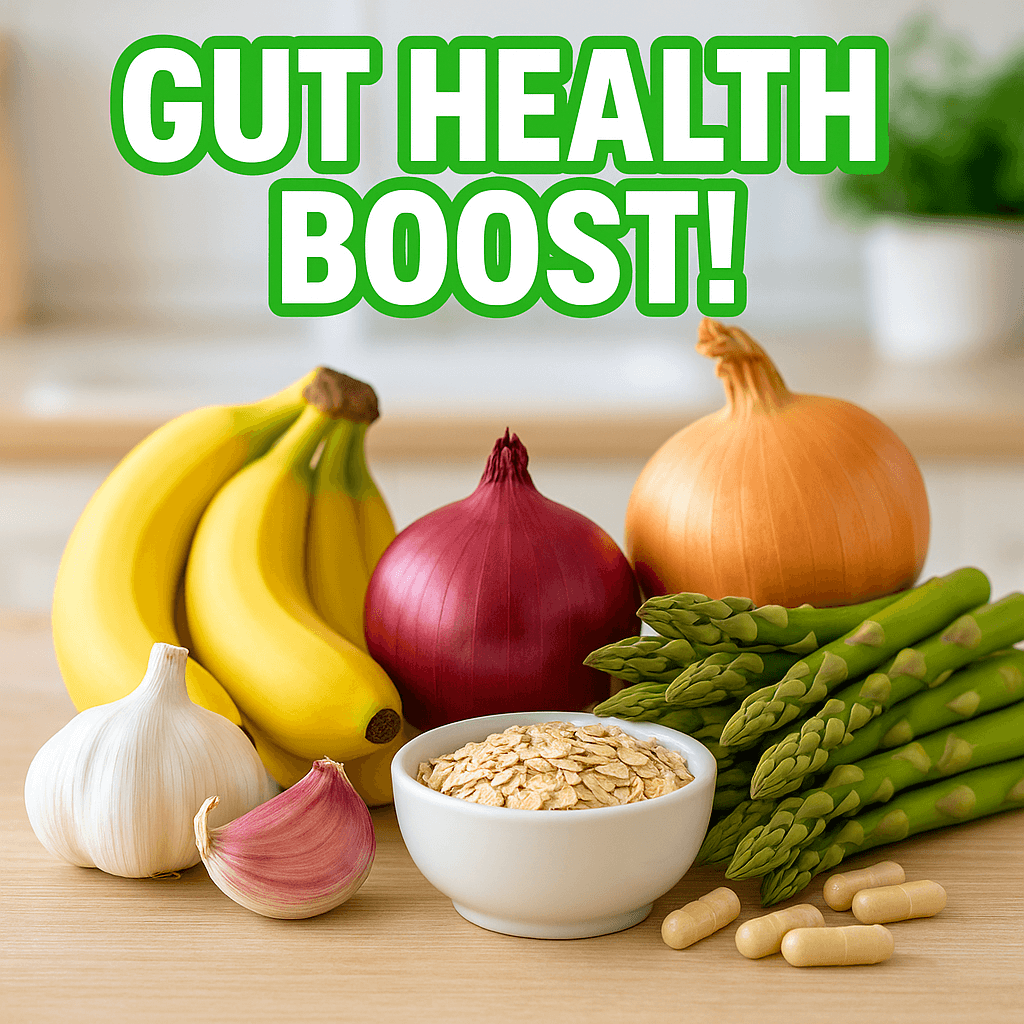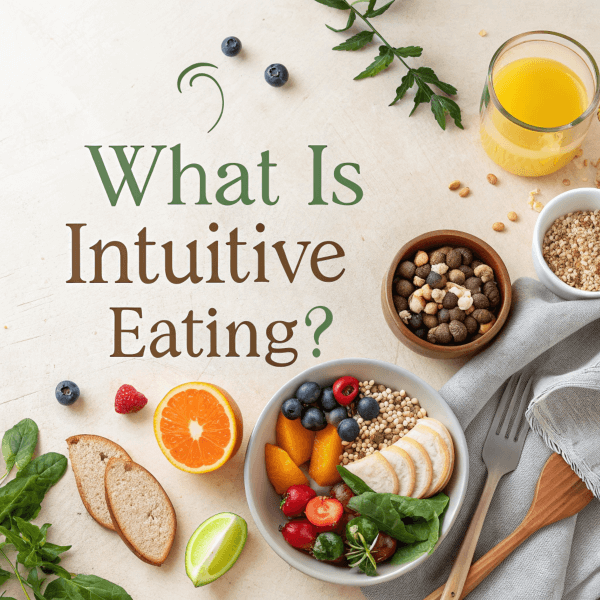Your digestive system houses trillions of microorganisms that directly impact your energy levels, immune function, and mental clarity. The key to optimizing this internal ecosystem lies in feeding these beneficial bacteria the right fuel: prebiotic foods. Unlike probiotics, which introduce new microorganisms, prebiotic foods nourish the beneficial bacteria already present in your gut, creating a thriving environment for optimal health.
This comprehensive guide reveals the 15 most effective prebiotic foods, explains the science behind their gut-transforming power, and provides practical strategies for incorporating them into your daily meals. Whether you’re dealing with digestive issues or want to enhance your overall wellness, these evidence-based recommendations will help you build a stronger, more resilient microbiome.
What Are Prebiotic Foods? The Science Simplified
Prebiotic foods contain specific types of dietary fiber that resist digestion in your upper gastrointestinal tract. These specialized fibers reach your colon intact, where they serve as premium fuel for beneficial bacteria like Bifidobacteria and Lactobacillus.
The most common prebiotic compounds include:
- Inulin: Found in chicory root, Jerusalem artichokes, and garlic
- Fructo-oligosaccharides (FOS): Present in onions, asparagus, and bananas
- Galacto-oligosaccharides (GOS): Abundant in legumes and certain nuts
- Resistant starch: Available in green bananas, cooked and cooled potatoes
- Beta-glucan: Concentrated in oats and barley
Prebiotic Foods vs. Probiotics: Understanding the Difference
| Aspect | Prebiotic Foods | Probiotics |
|---|---|---|
| Function | Feed existing beneficial bacteria | Introduce new live bacteria |
| Source | Plant-based fibers and starches | Fermented foods and supplements |
| Stability | Heat-stable, long shelf life | Sensitive to heat, limited shelf life |
| Daily Target | 5–25 grams of prebiotic fiber | 1–10 billion CFU |
| Cost | Generally inexpensive | Often more expensive |
The most effective approach combines both strategies—consuming prebiotic foods to nourish your existing microbiome while occasionally adding probiotics to introduce beneficial strains.
How Prebiotic Foods Work in Your Body
When you consume prebiotic foods, they embark on a specific journey through your digestive system:
- Upper Digestive Tract: Prebiotic fibers resist breakdown by stomach acid and small intestine enzymes, arriving in your colon largely intact.
- Bacterial Fermentation: Beneficial bacteria in your colon ferment these fibers, producing short-chain fatty acids (SCFAs), including butyrate, propionate, and acetate.
- Gut Barrier Strengthening: SCFAs fuel the cells lining your intestinal wall, strengthening the gut barrier and reducing inflammation.
- Systemic Benefits: These compounds enter your bloodstream, supporting immune function, regulating blood sugar, and even influencing brain health through the gut-brain axis.
Research shows that regular consumption of prebiotic foods can increase beneficial bacteria populations by 10-100 fold within just 2-4 weeks, making them one of the fastest ways to improve gut health.
The Top 15 Prebiotic Foods (Ranked by Effectiveness)
1. Chicory Root (47g prebiotic fiber per 100g)
The undisputed champion of prebiotic foods, chicory root contains nearly 50% inulin by weight. Often ground and used as a coffee substitute, it provides an impressive dose of gut-nourishing fiber.
How to use: Brew chicory root coffee, add powdered chicory to smoothies, or look for chicory-enriched foods.
2. Jerusalem Artichoke (18g prebiotic fiber per 100g)
Also known as sunchokes, these tubers deliver substantial amounts of inulin and FOS. Their slightly sweet, nutty flavor makes them versatile for cooking.
How to use: Roast like potatoes, slice raw into salads, or add to soups and stews.
3. Dandelion Greens (13g prebiotic fiber per 100g)
These often-overlooked leafy greens pack impressive prebiotic power alongside vitamins A, C, and K.
How to use: Sauté with garlic, add young leaves to salads, or blend into green smoothies.
4. Garlic (12g prebiotic fiber per 100g)
Raw garlic provides maximum prebiotic benefits, though cooked garlic retains significant fiber content while being easier to digest.
How to use: Mince raw cloves into dressings, add to cooked dishes, or roast whole cloves for a milder flavor.
5. Raw Leeks (11g prebiotic fiber per 100g)
The white and light green portions of leeks offer substantial inulin content with a mild onion-like flavor.
How to use: Add to soups, sauté with other vegetables, or include in stir-fries.
6. Onions (9g prebiotic fiber per 100g)
Common yellow and white onions provide readily available prebiotic fiber that’s easy to incorporate into meals.
How to use: Caramelize for natural sweetness, add raw to salads, or include in virtually any savory dish.
7. Flaxseeds (11g prebiotic fiber per 30g serving)
Ground flaxseeds offer mucilaginous fiber that feeds beneficial bacteria while providing omega-3 fatty acids.
How to use: Grind fresh and add to yogurt, oatmeal, or smoothies. Store ground flaxseed in the refrigerator.
8. Green Bananas (5g resistant starch per medium banana)
Unripe bananas contain resistant starch that acts as a prebiotic, feeding beneficial bacteria in your colon.
How to use: Blend into smoothies, slice into cereal, or cook in savory dishes common in Caribbean cuisine.
9. Oats (5g prebiotic fiber per 100g dry)
Steel-cut and rolled oats provide beta-glucan fiber that supports both gut health and cholesterol management.
How to use: Make overnight oats, prepare warm oatmeal, or add oat flour to baked goods.
10. Barley (4g prebiotic fiber per 100g)
This ancient grain offers beta-glucan and becomes even more prebiotic-rich when cooked and cooled.
How to use: Add to soups, make barley pilaf, or use pearl barley in grain bowls.
11. Asparagus (3g prebiotic fiber per 100g)
Fresh asparagus spears provide inulin along with folate and vitamins A, C, and K.
How to use: Steam lightly, roast with olive oil, or add to stir-fries and pasta dishes.
12. Lentils (3g prebiotic fiber per 100g cooked)
These protein-rich legumes offer galacto-oligosaccharides (GOS) that specifically feed Bifidobacterium species.
How to use: Make lentil soups, add to salads, or use in Indian dal preparations.
13. Chickpeas (3g prebiotic fiber per 100g cooked)
Versatile legumes that provide both protein and prebiotic fiber, making them excellent for gut health.
How to use: Roast for snacks, make hummus, or add to grain bowls and curries.
14. Apples (2g prebiotic fiber per medium apple with skin)
The pectin in apple skin acts as a prebiotic while providing additional nutrients and antioxidants.
How to use: Eat with skin on, add to oatmeal, or include in both sweet and savory dishes.
15. Seaweed (1-2g prebiotic fiber per 100g)
Wakame and other sea vegetables contain unique prebiotic compounds like fucoidan that support gut health.
How to use: Add to miso soup, include in salads, or use as a seasoning in Asian-inspired dishes.
Daily Meal Planning with Prebiotic Foods
Target Intake
Aim for 15-25 grams of prebiotic fiber daily to see meaningful changes in your gut microbiome. Start with 5-10 grams and gradually increase to prevent digestive discomfort.
Sample Daily Menu (22g prebiotic fiber)
Breakfast: Overnight oats with ground flaxseed, sliced apple, and a drizzle of chicory fiber syrup (8g prebiotic fiber)
Lunch: Lentil and barley soup with sautéed leeks and garlic (7g prebiotic fiber)
Snack: Green banana smoothie with a handful of berries (4g prebiotic fiber)
Dinner: Roasted Jerusalem artichokes with steamed asparagus and grilled chicken (3g prebiotic fiber)
Quick Preparation Tips
Batch Cooking: Prepare large amounts of lentils, chickpeas, and barley on weekends for easy meal assembly.
Raw Additions: Keep minced garlic in olive oil, sliced raw onions, and ground flaxseed readily available for quick prebiotic boosts.
Cooling Trick: Cook potatoes, rice, and pasta, then refrigerate overnight to increase resistant starch content before reheating.
Safety Guidelines and Potential Side Effects
Common Side Effects
Rapidly increasing prebiotic foods intake can cause:
- Bloating and gas
- Abdominal discomfort
- Changes in bowel movements
- Increased flatulence
Gradual Introduction Protocol
- Week 1-2: Add 2-3 grams of prebiotic fiber daily
- Week 3-4: Increase to 5-8 grams daily
- Week 5+: Gradually reach your target of 15-25 grams daily
Special Considerations
IBS and FODMAP Sensitivity: People with irritable bowel syndrome may need to limit high-FODMAP prebiotic foods like garlic, onions, and Jerusalem artichokes. Consider working with a registered dietitian.
SIBO (Small Intestinal Bacterial Overgrowth): Those with SIBO should consult healthcare providers before significantly increasing prebiotic foods, as these may exacerbate symptoms.
Digestive Disorders: Individuals with Crohn’s disease, ulcerative colitis, or other inflammatory bowel conditions should introduce prebiotic foods slowly and under medical supervision.
Maximizing Tolerance
- Hydrate adequately: Aim for 8-10 glasses of water daily
- Chew thoroughly: Proper chewing aids digestion and reduces gas
- Cook when possible: Cooking breaks down some fibers, making them easier to digest
- Combine wisely: Pair prebiotic foods with easily digestible proteins and fats
Prebiotic Supplements vs. Whole Foods
When Supplements Make Sense
- Travel: Maintaining fiber intake while away from home
- Severe food restrictions: Medical diets that limit fiber-rich foods
- Therapeutic doses: Achieving specific fiber targets for health conditions
- Convenience: Busy lifestyles that make food preparation challenging
Whole Foods Advantages
- Nutrient density: Vitamins, minerals, and antioxidants alongside prebiotic fiber
- Cost-effectiveness: Generally less expensive than supplements
- Satiety: Whole foods provide satisfaction and fullness
- Synergistic compounds: Multiple beneficial compounds working together
Quality Supplement Considerations
If choosing supplements, look for:
- Third-party testing for purity and potency
- Specific fiber types rather than generic “fiber blends”
- Minimal additives and artificial ingredients
- Appropriate dosing starting with 3-5 grams daily
Cost Comparison
A month’s supply of prebiotic foods (focusing on affordable options like oats, lentils, and onions) typically costs $15-25, while quality prebiotic supplements range from $25-50 monthly.
Maximizing Prebiotic Foods Benefits
Timing Strategies
Morning: Start with a prebiotic-rich breakfast to fuel beneficial bacteria throughout the day.
Pre-meal: Consume a small amount of prebiotic foods 15-30 minutes before meals to optimize digestion.
Consistent intake: Spread prebiotic foods throughout the day rather than consuming large amounts at once.
Combination Approaches
Synbiotics: Combine prebiotic foods with probiotic-rich foods like yogurt, kefir, or fermented vegetables for maximum benefit.
Polyphenol pairing: Include colorful fruits and vegetables alongside prebiotic foods to provide additional compounds that support beneficial bacteria.
Healthy fats: Pair prebiotic foods with sources like olive oil, avocado, or nuts to enhance nutrient absorption.
Storage and Preparation Tips
- Jerusalem artichokes: Store in cool, dark places and consume within a week of purchase
- Flaxseeds: Grind fresh and refrigerate to prevent rancidity
- Garlic: Allow chopped garlic to sit for 10 minutes before cooking to maximize prebiotic compounds
- Green bananas: Buy when very green and use before they ripen for maximum resistant starch
The Future of Prebiotic Research
Emerging research continues to reveal new applications for prebiotic foods:
Mental Health: Studies suggest prebiotic foods may support anxiety and depression management through the gut-brain axis.
Weight Management: Certain prebiotic fibers show promise for supporting healthy weight maintenance and reducing food cravings.
Immune Function: Research indicates prebiotic foods may enhance vaccine responses and reduce infection risk.
Metabolic Health: Ongoing studies explore how prebiotic foods might support blood sugar control and cardiovascular health.
Transform Your Gut Health Starting Today
The path to better digestive health and overall wellness begins with a single step: adding more prebiotic foods to your daily routine. Start by choosing two or three foods from this list that appeal to your taste preferences and current cooking habits.
Consider beginning with versatile options like oats for breakfast, garlic and onions in your cooking, and an apple as an afternoon snack. These simple additions can provide 8-12 grams of prebiotic fiber daily—enough to begin positive changes in your gut microbiome.
Remember that consistency matters more than perfection. Your beneficial gut bacteria thrive on regular nourishment, so focus on creating sustainable habits rather than dramatic dietary overhauls.
Track how you feel over the next 2-4 weeks as you increase your prebiotic foods intake. Many people report improved digestion, more stable energy levels, and better overall well-being within this timeframe.
Your gut microbiome is unique, so experiment with different prebiotic foods to discover which ones work best for your body. With patience and consistency, these 15 powerful foods can help you build a thriving internal ecosystem that supports your health for years to come.
Start your gut health transformation today—your future self will thank you for taking this important step toward optimal wellness.




